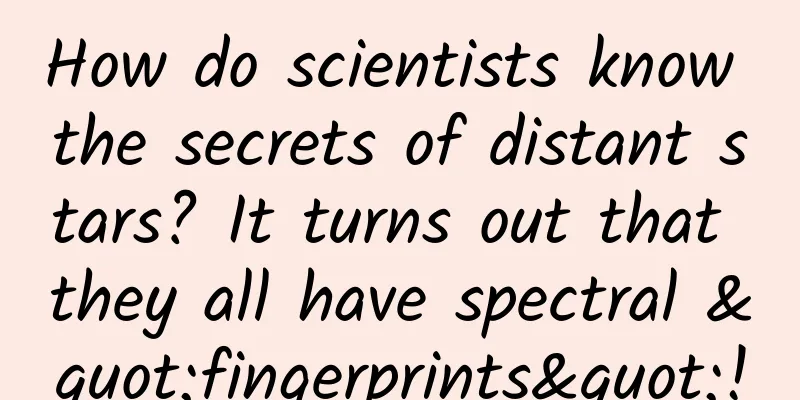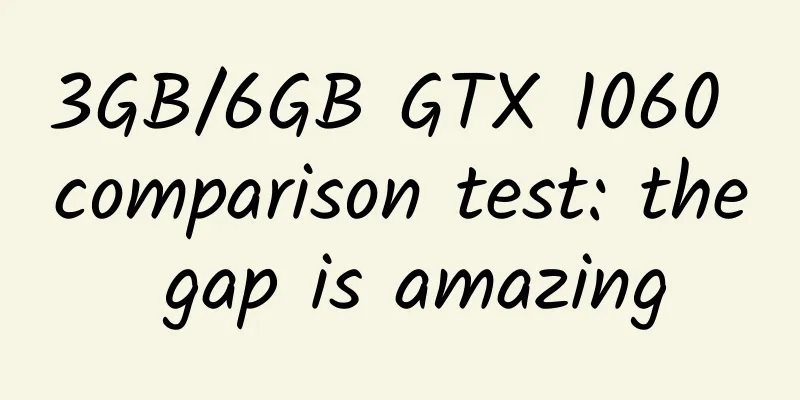How do scientists know the secrets of distant stars? It turns out that they all have spectral "fingerprints"!

|
On March 30 this year, the world-renowned scientific magazine Nature published an article claiming that NASA (National Aeronautics and Space Administration) used the Hubble telescope to discover the most distant star to date, numbered WHL0137-LS and named Earendel, which means "Morning Star" or "Sunrise Light". The study believes that this star is about 12.9 billion light-years away from us, with a mass of more than 50 times that of the sun, and is a huge blue star. Before this, the farthest star was MACS J1149 + 2223 Lensed Star-1 (LS1 for short), also known as Ikaros, discovered in 2018, which is about 9.3 billion light-years away from us. These stars were discovered through the magnification effect of gravitational lensing. Although they are very blurry, scientists can still find their identity information from a little starlight. Scientists can tell about many stars that are billions of light years away. So, how do scientists know the information of these stars? It turns out that scientists have many scientific methods to explore the secrets of these distant stars. One of the most important methods is to analyze the stellar spectrum. Stellar spectra can reveal many deep secrets of stars. No two stars have exactly the same spectra, so stellar spectra are known as the fingerprints of stars. Scientists have mastered this "fingerprint" of stars, which allows them to understand the basic parameters and details of distant stars. Let's learn about it together. How spectral fingerprints are formed/ We know that everyone has different fingerprints, and there are no two identical fingerprints in the world. This is why people can find a person among more than 7 billion people through the fingerprint information left by that person. But if you say that stars also have fingerprints, many people certainly don't believe it. A star is a huge ball of fire, how can it grow fingerprints? This statement is correct, but the fingerprints here are not real fingerprints, but a method similar to fingerprints that can identify information. In humans, fingerprints are often related to a person's identity information. By comparing fingerprints, you can understand the person's gender, age, birthplace, ethnicity, credit status and other information, so fingerprints are also similar to ID cards. The same is true for stars. Since each star is born in a different environment, time, material composition, mass, evolution process, and distance, the light emitted is different. The stellar spectrum can subtly depict these differences, thus forming the star's "fingerprint." Spectrum refers to the color and spectrum of light. The light we see with our eyes is called visible light, which is composite light. For example, sunlight is composed of red, orange, yellow, green, cyan, blue, and purple. Because different colors of light have different wavelengths and refractive indices, dispersion occurs when passing through a prism, separating the different colors of light. The wavelength of visible light is between 380 and 780 nanometers, with violet light having the shortest wavelength and red light having the longest wavelength. The energy is inversely proportional to the wavelength. Visible light is a small part of the electromagnetic spectrum. In addition to visible light, electromagnetic waves also include invisible light, such as radio, infrared, ultraviolet, X-rays, gamma rays, etc. Light waves are electromagnetic radiation generated by electrons in the process of atomic movement. The internal electrons of different substances and the movement of these electrons at different energies are different, so different substances emit different light waves in different states. There are 118 elements in the universe that have been discovered, and the light waves emitted by each element are different. There are spectral lines in the spectrum, which refer to dark or bright lines in a uniform continuous spectrum. Each atom has its own characteristic spectral line. Therefore, the characteristics of the spectral line can be used to identify which atom or molecule emits light. Spectral lines follow Kirchhoff's law, that is, each chemical element can produce radiation at high temperature and emit a unique bright line spectrum; at low temperature, it absorbs the radiation it can emit, thus turning the bright lines in the spectrum into dark lines. Scientists obtain spectral samples of various elements under various conditions in the laboratory. With these samples, by comparing and analyzing the spectra of various light sources collected, they can find out what elements these light sources are emitted from and the abundance (ratio) of various elements. This is why scientists can get the state of stars through stellar spectrum analysis. Through the analysis of star spectra, we can also know the size and life span of stars. Through long-term observations of stars, scientists have discovered a pattern: the larger the mass of a star, the higher its luminosity and the higher its surface temperature. In this way, the mass of a star can be inferred from its brightness. The most commonly used stellar spectrum classification system was proposed by the Harvard Observatory in the United States in the late 19th century. It is called the Harvard system. This system divides stellar spectra into types such as O, B, A, F, G, K, and M. Each spectral type is divided into 10 sub-types, marked with Arabic numerals 0 to 9. However, among the stars observed now, the hottest star is O5, and the dimmest star is M5. So there are only 6 subcategories of O type and 5 subcategories of M type. So far, only 61 subcategories have been observed. O-type stars are stars with a mass 20 to 150 times greater than that of the sun, appear blue, have a surface temperature of 25,000 to 55,000 K, and an absolute brightness 200,000 to 5 million times that of the sun. There are very few such giant stars in the Milky Way, accounting for about 0.00003% of the total number of stars. M-type spectral stars refer to the smallest red dwarf stars, with a mass less than 0.4 times that of the sun, and the smallest is only 0.08 times the mass of the sun, with a surface temperature of 2000~3500 K. This type of star is the mainstream star in the Milky Way, accounting for about 76.45% of the total number of stars. The sun belongs to the G-type spectrum, which includes stars with 0.8 to 1.2 times the mass of the sun. They are yellow in color, so they are also called yellow dwarfs. Their surface temperatures are between 5000 and 6000 K, accounting for about 7.8% of the Milky Way. The sun is a yellow dwarf with a mass of 1.9896*10^30 kg. There are some other classification methods and types of stellar spectra, which will not be discussed here. The life span of a star is inversely proportional to its mass. That is, the more massive a star is, the more intense its nuclear reaction will be due to its extremely high internal temperature and pressure, the faster it will burn, the more fuel it will consume, and therefore the shorter its life span will be. Conversely, the life span will be longer. Therefore, scientists can obtain the mass of a star by analyzing its spectrum, and from this they can determine the life span of the star. By analyzing the ratio of elements in the star spectrum and the abundance of various elements, we can get the stage of star evolution and how long it will last. This is because stars are constantly undergoing nuclear fusion from the moment they are born, causing the composition of stars to change continuously. This is a bit like understanding human age. Doctors know the bone density, body tissue status and other indicators of humans at different age groups, and can roughly know the person's age by looking at the examination and test reports. From the star spectrum, we can also get the distance between the star and us. There are two commonly used methods to obtain the distance of a star from our star spectrum: one is to convert the absolute magnitude of the star with the visual magnitude to obtain the distance of the star; the other is to calculate the distance of the star by the redshift or blueshift of the star's spectrum. Absolute magnitude and visual magnitude are both indicators of star brightness, and are expressed in numerical values. The larger the value, the dimmer it is, and vice versa. There are also negative numbers, and the more negative the number, the brighter the star. Each level of brightness differs by 2.512 times, so the brightness difference between levels is an exponent of 2.512 times. For example, if there is a difference of 5 magnitudes between a 1st-magnitude star and a 6th-magnitude star, the brightness difference is 2.512 to the fifth power, which is about 100 times. The absolute magnitude is the absolute brightness of a star. In theory, the brightness of stars is compared by placing them on the same starting line of 10 parsecs. Therefore, the absolute magnitude is the true brightness of the star. Parsec is the unit of distance of celestial bodies in the universe. 1 parsec is about 3.26 light years, and 10 parsecs is 32.6 light years. Visual magnitude is the brightness of stars as seen by the naked eye (including the brightness conversion seen by telescopes). Since stars are far away or near, the brightness seen by the human eye cannot represent the true brightness of the stars. Stars with greater absolute brightness will appear darker due to their greater distance; while stars with lower absolute brightness will appear brighter due to their close distance. For example, the absolute magnitude of the Sun is 4.83, and the visual magnitude is -26.74; the absolute magnitude of Sirius A is 1.42, and the visual magnitude is -1.47. Comparing the absolute magnitudes of these two stars, Sirius is about 23 times brighter than the Sun, but the visual brightness of Sirius is completely incomparable to that of the Sun. The sun is so huge and far away that it is impossible to look directly at it. Sirius is just a star, and the sun's visual magnitude is 12.8 billion times brighter than Sirius. This is because the sun is only 150 million kilometers away from us, while Sirius is 8.6 light years away, more than 60,000 times the distance of the sun. If Sirius were moved to the position of the sun, its brightness would reach -30 magnitude, still about 23 times that of the sun. The conversion formula between absolute magnitude and apparent magnitude is: m=M-5log(d0/d) or M=m+5log(d0/d). The former formula is to convert the visual magnitude from the known absolute magnitude, and the latter formula is to convert the absolute magnitude from the known visual magnitude. In the formula, m represents the visual magnitude, M represents the absolute magnitude, d0 is 10 parsecs (32.6 light years), and d is the actual distance of the celestial body. From the formula, we can also see that the relationship between absolute magnitude and visual magnitude is proportional to distance. Since we can get the absolute magnitude of a star from the spectral type, and determine the apparent magnitude of a star with the naked eye or a telescope, we can calculate the actual distance between the star and us. The spectral redshift or blueshift method is based on the fact that any object moving in a wave-like manner has a Doppler effect. That is, when the wave source approaches us, the wavelength will be compressed and shortened, and the frequency will become higher; conversely, the wavelength will be elongated and the frequency will become lower. For light waves, the wavelength of red light is longer and the wavelength of blue-violet light is shorter. Therefore, when the light wave source moves away from us, the spectral line will move to the red end; conversely, it will move to the blue-violet end. This is called the redshift and blueshift of the spectrum. Redshift means that the light source is moving away from us, and blueshift means that the light source is moving towards us. By measuring the redshift or blueshift value of the star's spectrum, scientists can get how fast the star is moving away from or approaching us. The redshift and blueshift values are directly proportional to the speed. The larger the value, the faster the speed. The modern standard cosmological model theory holds that the universe is expanding isotropically. Distant galaxies and stars are moving away from us at a speed that is linearly proportional to the distance. That is, the farther the galaxy is, the faster it moves away. The astronomer Edwin Hubble, who discovered this law, established the Hubble's Law, which can be expressed as: V= H*D. In this formula, V represents the speed at which a distant galaxy is moving away from us, H is the Hubble constant, and D is the actual distance between the galaxy and us. Therefore, if we get the speed at which a star is moving away from us from the red shift of the spectrum, we can calculate the distance between the star and us using the Hubble constant. The Hubble constant refers to the speed at which a galaxy moves away from us at a million parsecs. In 2013, the European Space Agency measured the Hubble constant using the Planck satellite to be 67.80 km/s, which means that at a distance of 3.26 million light-years, the galaxy is moving away from us at a speed of about 67.8 km per second. In this way, we can calculate through the redshift value that the speed at which a certain star is moving away from us is 1000 kilometers per second. According to Hubble's law, we can calculate that the distance of this star from us is: 1000/67.8*3260000≈48.08 million light-years. However, using spectral redshift to calculate distance is only applicable to distances greater than 3.26 million light years, because the expansion of the universe is a large-scale expansion. In a small-scale range, the expansion effect is not obvious, and celestial bodies are still mainly bound by gravity and will move closer to each other. For example, the Andromeda Galaxy and the Milky Way are approaching each other at a speed of about 300 kilometers per second due to their huge mutual gravity, and a collision and fusion is expected to occur between 3 and 4 billion years. In short, the stellar spectrum is the fingerprint and ID card of each star, which contains a lot of stellar information. Scientists can establish an identity file for each star by analyzing the stellar spectrum. What do you think about this? Welcome to discuss, thank you for reading. The copyright of Space-Time Communication is original. Please do not copy or infringe upon the copyright. Thank you for your understanding and cooperation. |
<<: If this kind of sound appears in your ears, it means you are not far from becoming deaf!
>>: The Mystery of Gigantopithecus and Humans in Lingnan's Prehistoric History
Recommend
Big data report: So this is your Weibo
(This report is about 4,200 words and takes about...
Will keeping long hair during pregnancy take away nutrients from the baby? Stop torturing pregnant women...
gossip "Will long hair compete with the baby...
How to run a marketing campaign with high conversion rate
This article summarizes my experience and feeling...
Looking into the future: How far are we from smart home?
Have you ever imagined that, as shown in science ...
Ocean Figures | Gong Yunchong: The First Person to Guard the Nansha Reefs
(Photo source: Ocean Archives WeChat Official Acc...
Where does the space station's oxygen come from?
If there is one thing in this world that is essen...
Implementing iPhone X’s FaceID feature with Python and deep learning
For Apple fans, the most discussed topic about th...
Why do early products need seed users?
When it comes to the concept of seed users , I be...
Is there really a big difference between a 200 yuan and a 2,000 yuan hair perm and dye at a barber shop?
Expert of this article: Wang Wenxiang, professor ...
How to do a good job in Zhihu promotion and traffic generation?
In fact, you only need to do these three things t...
The intestines can determine the brain. Our cognition has been overturned again, right?
Recently, in a new study published in Science, a ...
So perverted! But I like it
When you want to watch a horror movie on the big ...
Metaverse, the next marketing trend!
Yesterday we talked about Facebook changing its n...
Dongfeng Peugeot is publicly reducing configuration but not lowering prices. Is this something or is there some other trick?
If it is a normal product, you get what you pay f...
How to create a Douyin product details page? What are the requirements?
Do Douyin store merchants know how to ensure the ...









